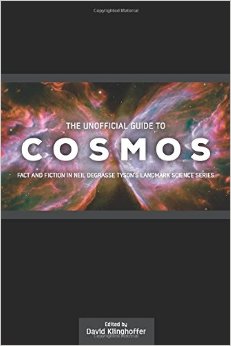 Faith & Science
Faith & Science
 Intelligent Design
Intelligent Design
Why Advocates of Intelligent Design Owe Atheist Neil deGrasse Tyson a "Thank You"
From living in Manhattan as I once did, I remember many taxi rides listening to the popular news station 1010 WINS with its slogan, "You give us 22 minutes, we’ll give you the world." And they did. The producers offered a picture in miniature not only of whatever they regarded as the top stories around the globe, but of their worldview that determined what news is important and what isn’t.
The same is true of Neil deGrasse Tyson’s highly regarded Cosmos series, whose 13 episodes ran earlier this year on Fox and National Geographic TV but will live on indefinitely in schools as a classroom video supplement for science teachers. You give Dr. Tyson 13 hours, and he’ll give you the universe from the standpoint of scientific atheism.
His picture of reality is widely shared in the media, education, and even entertainment. Cosmos, after all, was executive produced by comedian Seth MacFarlane of Family Guy fame, who made clear that he had intelligent design (ID) in his crosshairs.
Scientific atheism (call it SA) is the default view in our culture. However, as received by a media or education consumer, its tenets are articulated unsystematically. Meeting its challenge is suited to blogging — as we do here at Evolution News & Views — but this leaves something to be desired. What you want is an opportunity to view the whole ball of wax that is SA, and offer the alternative: a scientific perspective open to recognizing design in the origin of the cosmos and the evolution of life.
With Cosmos, Neil Tyson hits every important point and premise that make up scientific atheism. From Darwinian evolution as the explanation of all complex features in life, to the myth of religion as archenemy of science, to panspermia, the multiverse, and catastrophic climate-change alarmism, along the way praising open-minded scientific exploration and freedom of thought, while simultaneously slandering genuine scientific skeptics as chumps at best, Nazis at worst — oh, it’s all there.
So we should say "Thank you" to the producers of Cosmos. Why? Because they provide the perfect occasion for articulating the counterview. That’s what we do in the new book I edited, The Unofficial Guide to Cosmos: Fact and Fiction in Neil deGrasse Tyson’s Landmark Science Series. Casey Luskin, Jay Richards, Douglas Ell, and I have gathered our responses to Cosmos not just to refute Tyson point for point but as a primer on design in cosmology and biology.
 You’ll find more information, including the Table of Contents and a sample chapter by Dr. Richards, at the book’s website.
You’ll find more information, including the Table of Contents and a sample chapter by Dr. Richards, at the book’s website.
Though our Unofficial Guide will help viewers of the program, including teachers, parents, and students who see it in school, it speaks also to someone who will never watch a single episode but wants to understand these two opposed ways of comprehending nature.
One way — scientific atheism, or methodological naturalism — sees reality as built up from matter exclusively. How matter got there to begin with it can’t say, other than to insist on an infinite multitude of universes. The "multiverse" is emitted by some unknown, undetectable universe-generating mechanism, mindlessly churning out parallel realities until one turned out to be just right to support our universe, fitting excruciatingly exact physical parameters and giving the illusion of intelligent fine-tuning.
Scientific atheism can’t abide the possibility of design in nature. This drives its whole mission. Intelligent design, as the name implies, doesn’t rule it out. ID theorists in fact find evidence of purposeful guidance from the macro level of cosmic fine-tuning at the Big Bang down to the most micro level of the intelligent programming in DNA.
Using Cosmos as a framework, Richards and Luskin in particular, two of the ID scholarly community’s most incisive advocates, blunt the attack from scientific atheism. But they also lay out the contrasting case that sees information, not matter, as the substrate of reality.
In his new book Being as Communion, a brilliantly innovative Discovery Institute colleague of ours, mathematician William Dembski, sketches the outline of ID as a worldview. In The Unofficial Guide to Cosmos we present the relevant evidence at a more popular level.
Obviously, we’re persuaded by the inference to design. But one interesting thing you find in examining Tyson presentation is that not only, objectively, does it fail to persuade. Worse, it’s shot through with distortions and falsehoods.
One of my favorite examples is his use of the ancient Chinese philosopher Mozi as a symbol of how religion opposes scientific advance. Mozi’s innovations included a camera obscura, which is why he shows up in Episode 5, dealing with light and its properties. Tyson gives an impression of Mozi as a proto-scientific atheist, author of a work titled "Against Faith," whose followers were persecuted for upholding his views.
Uh, no. As we show, the historical reality is quite different. Mozi was a very forward-looking monotheist and his book was titled not "Against Faith" but "Against Fate." His spiritual philosophy was opposed to fatalism, not religion. And his disciples were persecuted for political reasons, not scientific ones, by competing followers of the philosopher Confucius.
At one point in the course of the show’s airing, admirers of Dr. Tyson in the academic community held an online discussion of whether his use of "taradiddles" (lies) could be excused as being all in a good cause, defending "science"!
What kind of science needs "taradiddles" to make its case? One that needs a thorough, critical, from-the-ground-up examination of its assumptions and its evidence. That’s what kind.

